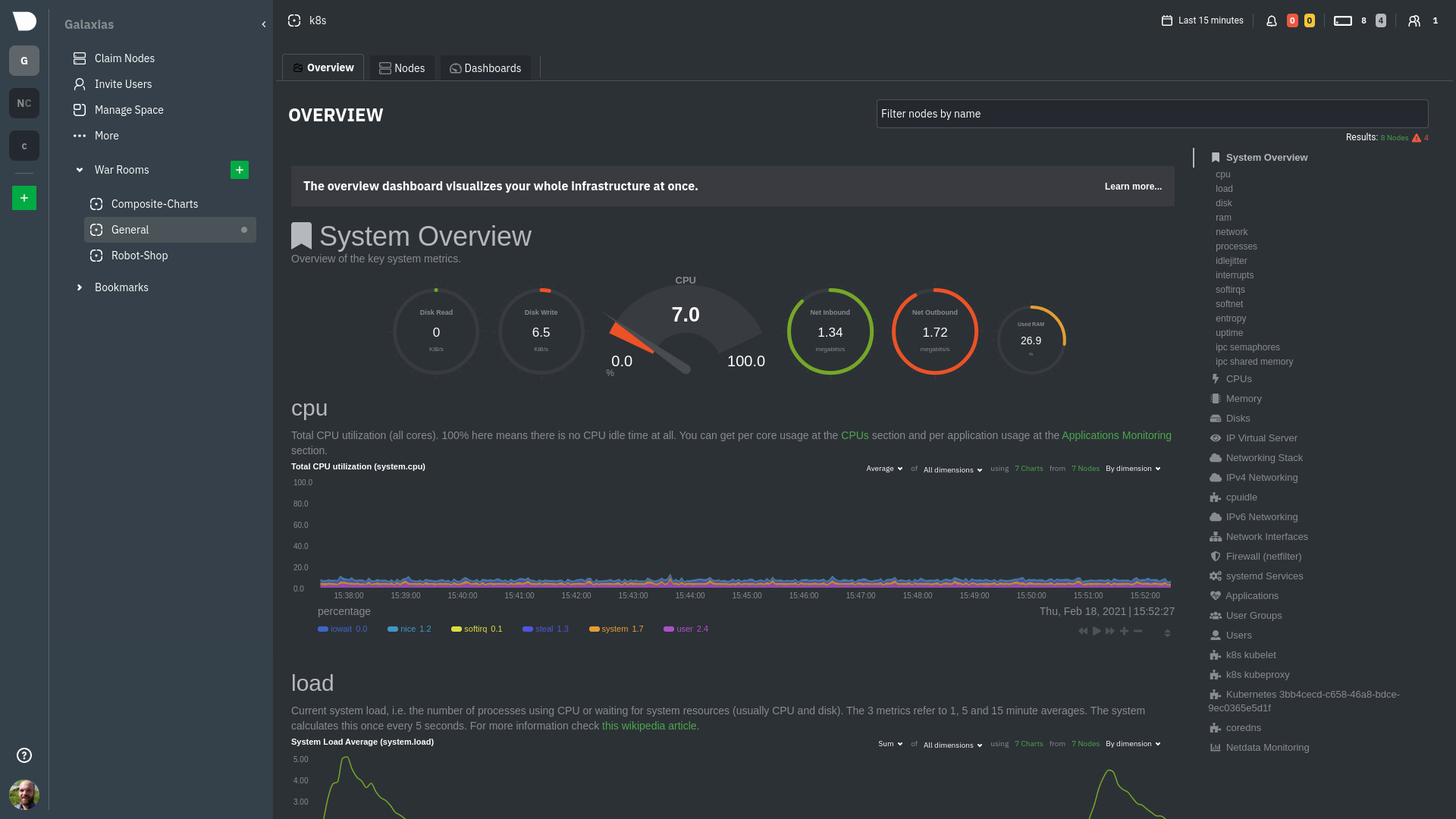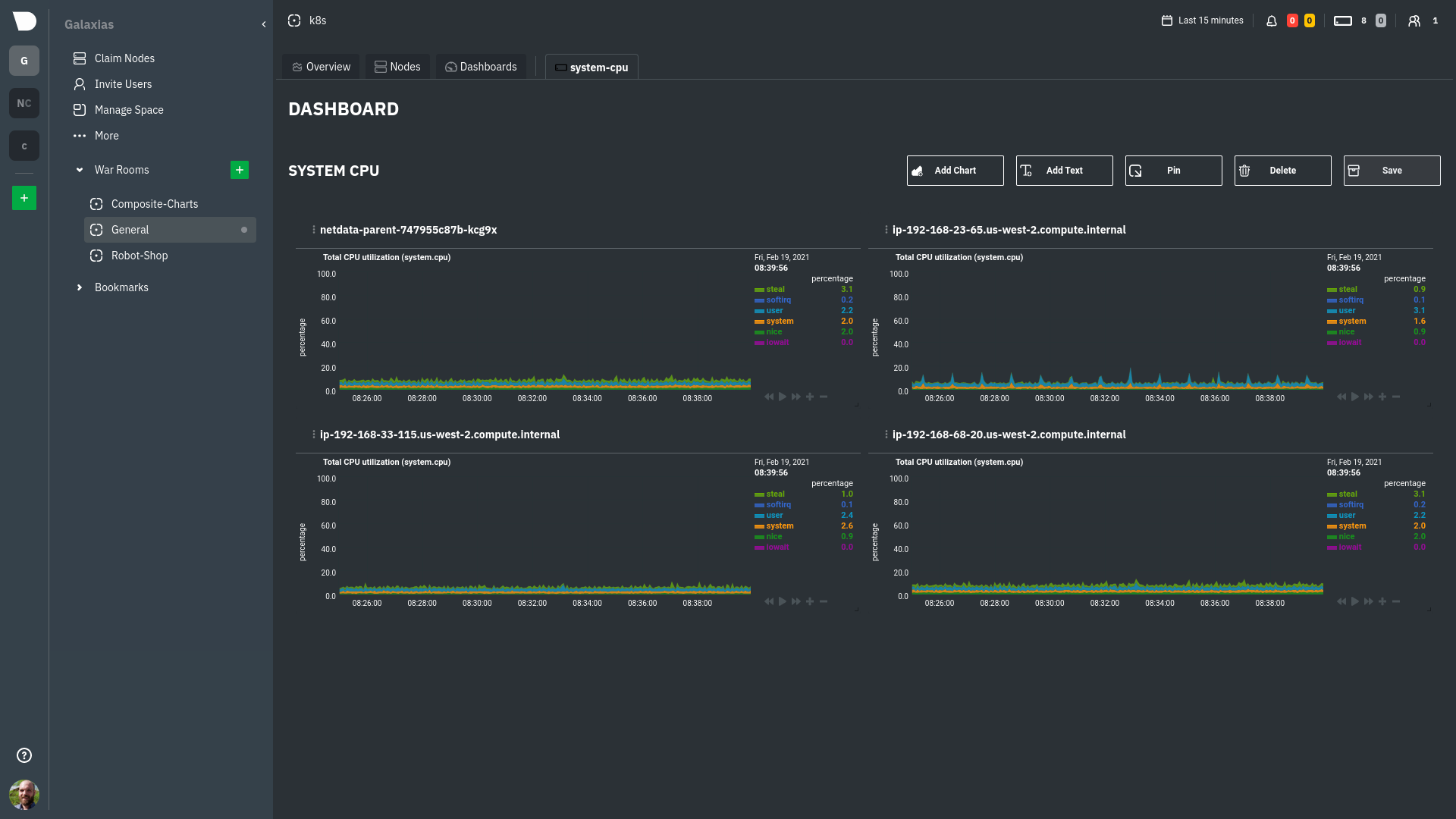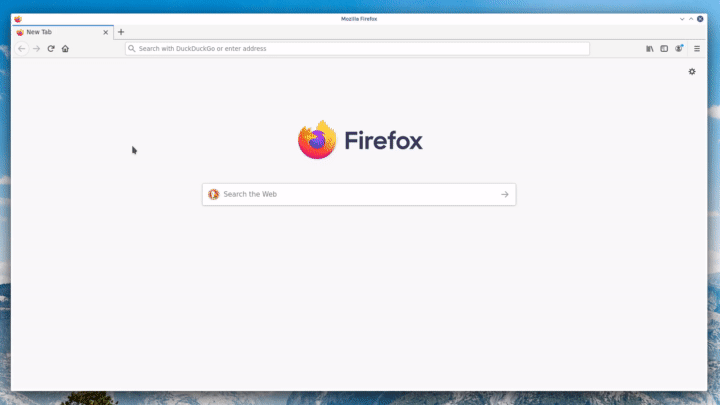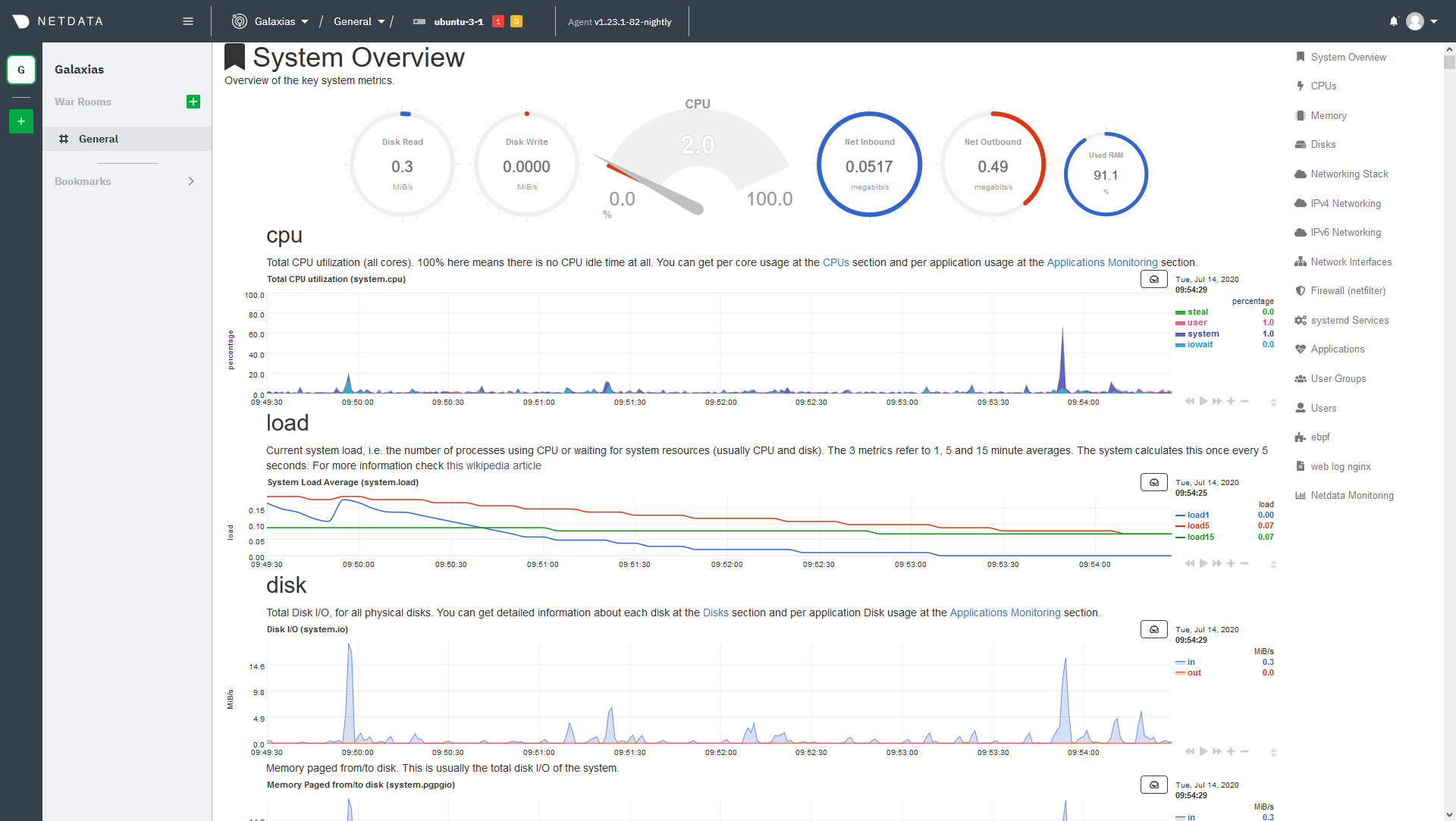diff options
Diffstat (limited to '')
| -rw-r--r-- | docs/quickstart/infrastructure.md | 169 | ||||
| -rw-r--r-- | docs/quickstart/single-node.md | 92 |
2 files changed, 105 insertions, 156 deletions
diff --git a/docs/quickstart/infrastructure.md b/docs/quickstart/infrastructure.md index 23986b002..c76948f60 100644 --- a/docs/quickstart/infrastructure.md +++ b/docs/quickstart/infrastructure.md @@ -1,11 +1,9 @@ -<!-- -title: "Infrastructure monitoring with Netdata" -sidebar_label: "Infrastructure monitoring" -description: "Build a robust, infinitely scalable infrastructure monitoring solution with Netdata. Any number of nodes and every available metric." -custom_edit_url: https://github.com/netdata/netdata/edit/master/docs/quickstart/infrastructure.md ---> +import { Grid, Box, BoxList, BoxListItemRegexLink } from '@site/src/components/Grid/' +import { RiExternalLinkLine } from 'react-icons/ri' -# Infrastructure monitoring with Netdata +# Monitor your infrastructure + +Learn how to view key metrics, insightful charts, and active alarms from all your nodes, with Netdata Cloud's real-time infrastructure monitoring. [Netdata Cloud](https://app.netdata.cloud) provides scalable infrastructure monitoring for any number of distributed nodes running the Netdata Agent. A node is any system in your infrastructure that you want to monitor, whether it's a @@ -14,7 +12,7 @@ physical or virtual machine (VM), container, cloud deployment, or edge/IoT devic The Netdata Agent uses zero-configuration collectors to gather metrics from every application and container instantly, and uses Netdata's [distributed data architecture](https://github.com/netdata/netdata/blob/master/docs/store/distributed-data-architecture.md) to store metrics locally. Without a slow and troublesome centralized data lake for your infrastructure's metrics, you reduce the -resources you need to invest in, and the complexity of, monitoring your infrastructure. +resources you need to invest in, and the complexity of, monitoring your infrastructure. Netdata Cloud unifies infrastructure monitoring by _centralizing the interface_ you use to query and visualize your nodes' metrics, not the data. By streaming metrics values to your browser, with Netdata Cloud acting as the secure proxy @@ -25,14 +23,8 @@ In this quickstart guide, you'll learn the basics of using Netdata Cloud to moni composite charts, and alarm viewing. You'll then learn about the most critical ways to configure the Agent on each of your nodes to maximize the value you get from Netdata. -This quickstart assumes you've installed the Netdata Agent on more than one node in your infrastructure, and connected -those nodes to your Space in Netdata Cloud. If you haven't yet, see the [Netdata -Cloud](https://github.com/netdata/netdata/blob/master/docs/cloud/cloud.mdx) docs for details on signing up for Netdata Cloud, installation, and -connection process. - -> If you want to monitor a Kubernetes cluster with Netdata, see our [k8s installation -> doc](https://github.com/netdata/netdata/blob/master/packaging/installer/methods/kubernetes.md) for setup details, and then read our guide, [_Monitor a Kubernetes -> cluster with Netdata_](https://github.com/netdata/netdata/blob/master/docs/guides/monitor/kubernetes-k8s-netdata.md). +This quickstart assumes you've [installed Netdata](https://github.com/netdata/netdata/edit/master/packaging/installer/README.md) +on more than one node in your infrastructure, and connected those nodes to your Space in Netdata Cloud. ## Set up your Netdata Cloud experience @@ -67,32 +59,49 @@ To [invite new users](https://github.com/netdata/netdata/blob/master/docs/cloud/ Space management Area. Choose which War Rooms to add this user to, then click **Send**. If your team members have trouble signing in, direct them to the [Netdata Cloud sign -in](https://github.com/netdata/netdata/blob/master/docs/cloud/manage/sign-in.mdx) doc. +in](https://github.com/netdata/netdata/blob/master/docs/cloud/manage/sign-in.md) doc. ### See an overview of your infrastructure -The default way to visualize the health and performance of an infrastructure with Netdata Cloud is the -[**Overview**](https://github.com/netdata/netdata/blob/master/docs/visualize/overview-infrastructure.md), which is the default interface of every War Room. The -Overview features composite charts, which display aggregated metrics from every node in a given War Room. These metrics -are streamed on-demand from individual nodes and composited onto a single, familiar dashboard. +Netdata Cloud utilizes "tabs" in order to provide you with informative sections based on your infrastructure. +These tabs can be separated into "static", meaning they are by default presented, and "non-static" which are tabs that get presented by user action (e.g clicking on a custom dashboard) + +#### Static tabs + +- The default tab for any War Room is the [Home tab](https://github.com/netdata/netdata/blob/master/docs/cloud/visualize/overview.md#home), which gives you an overview of this Space. + Here you can see the number of Nodes claimed, data retention statics, users by role, alerts and more. + +- The second and most important tab is the [Overview tab](https://github.com/netdata/netdata/blob/master/docs/cloud/visualize/overview.md#overview-and-single-node-view) which uses composite charts to display real-time metrics from every available node in a given War Room. + +- The [Nodes tab](https://github.com/netdata/netdata/blob/master/docs/cloud/visualize/nodes.md) gives you the ability to see the status (offline or online), host details, alarm status and also a short overview of some key metrics from all your nodes at a glance. + +- [Kubernetes tab](https://github.com/netdata/netdata/blob/master/docs/cloud/visualize/kubernetes.md) is a logical grouping of charts regarding your Kubernetes clusters. It contains a subset of the charts available in the **Overview tab**. + +- The [Dashboards tab](https://github.com/netdata/netdata/blob/master/docs/cloud/visualize/dashboards.md) gives you the ability to have tailored made views of specific/targeted interfaces for your infrastructure using any number of charts from any number of nodes. + +- The [Alerts tab](https://github.com/netdata/netdata/blob/master/docs/monitor/view-active-alarms.md) provides you with an overview for all the active alerts you receive for the nodes in this War Room, you can also see all the alerts that are configured to be triggered in any given moment. + +- The [Anomalies tab](https://github.com/netdata/netdata/blob/master/docs/cloud/insights/anomaly-advisor.md) is dedicated to the Anomaly Advisor tool. - +- The [Functions tab](https://github.com/netdata/netdata/blob/master/docs/cloud/netdata-functions.md) gives you the ability to visualize functions that the Netdata Agent collectors are able to expose. -Read more about the Overview in the [infrastructure overview](https://github.com/netdata/netdata/blob/master/docs/visualize/overview-infrastructure.md) doc. +- The [Feed & events](https://github.com/netdata/netdata/blob/master/docs/cloud/insights/events-feed.md) tab lets you investigate events that occurred in the past, which is invaluable for troubleshooting. -Netdata Cloud also features the [**Nodes view**](https://github.com/netdata/netdata/blob/master/docs/cloud/visualize/nodes.md), which you can -use to configure and see a few key metrics from every node in the War Room, view health status, and more. +#### Dynamic tabs + +If you open a [new dashboard](https://github.com/netdata/netdata/blob/master/docs/cloud/visualize/dashboards.md), jump to a single-node dashboard, or navigate to a dedicated alert page, a new tab will open in War Room bar. + +Tabs can be rearranged with drag-and-drop or closed with the **X** button. Open tabs persist between sessions, so you can always come right back to your preferred setup. ### Drill down to specific nodes -Both the Overview and Nodes view offer easy access to **single-node dashboards** for targeted analysis. You can use +Both the Overview and the Nodes tab offer easy access to **single-node dashboards** for targeted analysis. You can use single-node dashboards in Netdata Cloud to drill down on specific issues, scrub backward in time to investigate historical data, and see like metrics presented meaningfully to help you troubleshoot performance problems. Read about the process in the [infrastructure overview](https://github.com/netdata/netdata/blob/master/docs/visualize/overview-infrastructure.md#drill-down-with-single-node-dashboards) doc, then learn about [interacting with -dashboards and charts](https://github.com/netdata/netdata/blob/master/docs/visualize/interact-dashboards-charts.md) to get the most from all of Netdata's real-time +dashboards and charts](https://github.com/netdata/netdata/blob/master/docs/cloud/visualize/interact-new-charts.md) to get the most from all of Netdata's real-time metrics. ### Create new dashboards @@ -104,7 +113,7 @@ from every node in your infrastructure on a single dashboard.  -Read more about [creating new dashboards](https://github.com/netdata/netdata/blob/master/docs/visualize/create-dashboards.md) for more details about the process and +Read more about [creating new dashboards](https://github.com/netdata/netdata/blob/master/docs/cloud/visualize/dashboards.md) for more details about the process and additional tips on best leveraging the feature to help you troubleshoot complex performance problems. ## Set up your nodes @@ -134,7 +143,7 @@ sudo ./edit-config netdata.conf Our [configuration basics doc](https://github.com/netdata/netdata/blob/master/docs/configure/nodes.md) contains more information about `netdata.conf`, `edit-config`, along with simple examples to get you familiar with editing your node's configuration. -After you've learned the basics, you should [secure your infrastructure's nodes](https://github.com/netdata/netdata/blob/master/docs/configure/secure-nodes.md) using +After you've learned the basics, you should [secure your infrastructure's nodes](https://github.com/netdata/netdata/blob/master/docs/netdata-security.md) using one of our recommended methods. These security best practices ensure no untrusted parties gain access to the metrics collected on any of your nodes. @@ -144,42 +153,74 @@ Netdata has [300+ pre-installed collectors](https://github.com/netdata/netdata/b configuration. Collectors search each of your nodes in default locations and ports to find running applications and gather as many metrics as they can without you having to configure them individually. -Most collectors work without configuration, but you should read up on [how collectors -work](https://github.com/netdata/netdata/blob/master/docs/collect/how-collectors-work.md) and [how to enable/configure](https://github.com/netdata/netdata/blob/master/docs/collect/enable-configure.md) them so -that you can see metrics from those applications in Netdata Cloud. +Most collectors work without configuration, should you want more info, you can read more on [how Netdata's metrics collectors work](https://github.com/netdata/netdata/blob/master/collectors/README.md) and the [Collectors configuration reference](https://github.com/netdata/netdata/blob/master/collectors/REFERENCE.md) documentation. In addition, find detailed information about which [system](https://github.com/netdata/netdata/blob/master/docs/collect/system-metrics.md), [container](https://github.com/netdata/netdata/blob/master/docs/collect/container-metrics.md), and [application](https://github.com/netdata/netdata/blob/master/docs/collect/application-metrics.md) metrics you can collect from across your infrastructure with Netdata. -## What's next? - -Netdata has many features that help you monitor the health of your nodes and troubleshoot complex performance problems. -Once you have a handle on configuration and are collecting all the right metrics, try out some of Netdata's other -infrastructure-focused features: - -- [See an overview of your infrastructure](https://github.com/netdata/netdata/blob/master/docs/visualize/overview-infrastructure.md) using Netdata Cloud's composite - charts and real-time visualizations. -- [Create new dashboards](https://github.com/netdata/netdata/blob/master/docs/visualize/create-dashboards.md) from any number of nodes and metrics in Netdata Cloud. - -To change how the Netdata Agent runs on each node, dig in to configuration files: - -- [Change how long nodes in your infrastructure retain metrics](https://github.com/netdata/netdata/blob/master/docs/store/change-metrics-storage.md) based on how - many metrics each node collects, your preferred retention period, and the resources you want to dedicate toward - long-term metrics retention. -- [Create new alarms](https://github.com/netdata/netdata/blob/master/docs/monitor/configure-alarms.md), or tweak some of the pre-configured alarms, to stay on top - of anomalies. -- [Enable notifications](https://github.com/netdata/netdata/blob/master/docs/monitor/enable-notifications.md) to Slack, PagerDuty, email, and 30+ other services. -- [Export metrics](https://github.com/netdata/netdata/blob/master/docs/export/external-databases.md) to an external time-series database to use Netdata alongside - other monitoring and troubleshooting tools. - -### Related reference documentation - -- [Netdata Cloud · Spaces](https://github.com/netdata/netdata/blob/master/docs/cloud/spaces.md) -- [Netdata Cloud · War Rooms](https://github.com/netdata/netdata/blob/master/docs/cloud/war-rooms.md) -- [Netdata Cloud · Invite your team](https://github.com/netdata/netdata/blob/master/docs/cloud/manage/invite-your-team.md) -- [Netdata Cloud · Sign in or sign up with email, Google, or - GitHub](https://github.com/netdata/netdata/blob/master/docs/cloud/manage/sign-in.mdx) -- [Netdata Cloud · Nodes view](https://github.com/netdata/netdata/blob/master/docs/cloud/visualize/nodes.md) - - +## Netdata Cloud features + +<Grid columns="2"> + <Box + title="Spaces and War Rooms"> + <BoxList> + <BoxListItemRegexLink to="[](https://github.com/netdata/netdata/blob/master/docs/cloud/spaces.md)" title="Spaces" /> + <BoxListItemRegexLink to="[](https://github.com/netdata/netdata/blob/master/docs/cloud/war-rooms.md)" title="War Rooms" /> + </BoxList> + </Box> + <Box + title="Dashboards"> + <BoxList> + <BoxListItemRegexLink to="[](https://github.com/netdata/netdata/blob/master/docs/cloud/visualize/overview.md)" title="Overview" /> + <BoxListItemRegexLink to="[](https://github.com/netdata/netdata/blob/master/docs/cloud/visualize/nodes.md)" title="Nodes tab" /> + <BoxListItemRegexLink to="[](https://github.com/netdata/netdata/blob/master/docs/cloud/visualize/kubernetes.md)" title="Kubernetes" /> + <BoxListItemRegexLink to="[](https://github.com/netdata/netdata/blob/master/docs/cloud/visualize/dashboards.md)" title="Create new dashboards" /> + </BoxList> + </Box> + <Box + title="Alerts and notifications"> + <BoxList> + <BoxListItemRegexLink to="[](https://github.com/netdata/netdata/blob/master/docs/monitor/view-active-alarms.md#netdata-cloud)" title="View active alerts" /> + <BoxListItemRegexLink to="[](https://github.com/netdata/netdata/blob/master/docs/cloud/alerts-notifications/notifications.md)" title="Alert notifications" /> + </BoxList> + </Box> + <Box + title="Troubleshooting with Netdata Cloud"> + <BoxListItemRegexLink to="[](https://github.com/netdata/netdata/blob/master/docs/cloud/insights/metric-correlations.md)" title="Metric Correlations" /> + <BoxListItemRegexLink to="[](https://github.com/netdata/netdata/blob/master/docs/cloud/insights/anomaly-advisor.md)" title="Anomaly Advisor" /> + <BoxListItemRegexLink to="[](https://github.com/netdata/netdata/blob/master/docs/cloud/insights/events-feed.md)" title="Events Feed" /> + </Box> + <Box + title="Management and settings"> + <BoxList> + <BoxListItemRegexLink to="[](https://github.com/netdata/netdata/blob/master/docs/cloud/manage/sign-in.md)" title="Sign in with email, Google, or GitHub" /> + <BoxListItemRegexLink to="[](https://github.com/netdata/netdata/blob/master/docs/cloud/manage/invite-your-team.md)" title="Invite your team" /> + <BoxListItemRegexLink to="[](https://github.com/netdata/netdata/blob/master/docs/cloud/manage/themes.md)" title="Choose your Netdata Cloud theme" /> + <BoxListItemRegexLink to="[](https://github.com/netdata/netdata/blob/master/docs/cloud/manage/role-based-access.md)" title="Role-Based Access" /> + <BoxListItemRegexLink to="[](https://github.com/netdata/netdata/blob/master/docs/cloud/manage/plans.md)" title="Paid Plans" /> + </BoxList> + </Box> +</Grid> + +- Spaces and War Rooms + - [Spaces](https://github.com/netdata/netdata/blob/master/docs/cloud/spaces.md) + - [War Rooms](https://github.com/netdata/netdata/blob/master/docs/cloud/war-rooms.md) +- Dashboards + - [Overview](https://github.com/netdata/netdata/blob/master/docs/cloud/visualize/overview.md) + - [Nodes tab](https://github.com/netdata/netdata/blob/master/docs/cloud/visualize/nodes.md) + - [Kubernetes](https://github.com/netdata/netdata/blob/master/docs/cloud/visualize/kubernetes.md) + - [Create new dashboards](https://github.com/netdata/netdata/blob/master/docs/cloud/visualize/dashboards.md) +- Alerts and notifications + - [View active alerts](https://github.com/netdata/netdata/blob/master/docs/monitor/view-active-alarms.md#netdata-cloud) + - [Alert notifications](https://github.com/netdata/netdata/blob/master/docs/cloud/alerts-notifications/notifications.md) +- Troubleshooting with Netdata Cloud + - [Metric Correlations](https://github.com/netdata/netdata/blob/master/docs/cloud/insights/metric-correlations.md) + - [Anomaly Advisor](https://github.com/netdata/netdata/blob/master/docs/cloud/insights/anomaly-advisor.md) + - [Events Feed](https://github.com/netdata/netdata/blob/master/docs/cloud/insights/events-feed.md) +- Management and settings + - [Sign in with email, Google, or GitHub](https://github.com/netdata/netdata/blob/master/docs/cloud/manage/sign-in.md) + - [Invite your team](https://github.com/netdata/netdata/blob/master/docs/cloud/manage/invite-your-team.md) + - [Choose your Netdata Cloud theme](https://github.com/netdata/netdata/blob/master/docs/cloud/manage/themes.md) + - [Role-Based Access](https://github.com/netdata/netdata/blob/master/docs/cloud/manage/role-based-access.md) + - [Paid Plans](https://github.com/netdata/netdata/blob/master/docs/cloud/manage/plans.md) diff --git a/docs/quickstart/single-node.md b/docs/quickstart/single-node.md deleted file mode 100644 index 293731911..000000000 --- a/docs/quickstart/single-node.md +++ /dev/null @@ -1,92 +0,0 @@ -<!-- -title: "Single-node monitoring with Netdata" -sidebar_label: "Single-node monitoring" -description: "Learn dashboard basics, configuring your nodes, and collecting metrics from applications to create a powerful single-node monitoring tool." -custom_edit_url: https://github.com/netdata/netdata/edit/master/docs/quickstart/single-node.md ---> - -# Single-node monitoring with Netdata - -Because it's free, open-source, and requires only 1% CPU utilization to collect thousands of metrics every second, -Netdata is a superb single-node monitoring tool. - -In this quickstart guide, you'll learn how to access your single node's metrics through dashboards, configure your node -to your liking, and make sure the Netdata Agent is collecting metrics from the applications or containers you're running -on your node. - -## See your node's metrics - -To see your node's real-time metrics, you need to access its dashboard. You can either view the local dashboard, which -runs on the node itself, or see the dashboard through Netdata Cloud. Both methods feature real-time, interactive, and -synchronized charts, with the same metrics, and use the same UI. - -The primary difference is that Netdata Cloud also has a few extra features, like creating new dashboards using a -drag-and-drop editor, that enhance your monitoring and troubleshooting experience. - -To see your node's local dashboard, open up your web browser of choice and navigate to `http://NODE:19999`, replacing -`NODE` with the IP address or hostname of your Agent. Hit `Enter`. - - - -To see a node's dashboard in Netdata Cloud, [sign in](https://app.netdata.cloud). From the **Nodes** view in your -**General** War Room, click on the hostname of your node to access its dashboard through Netdata Cloud. - - - -Once you've decided which dashboard you prefer, learn about [interacting with dashboards and -charts](https://github.com/netdata/netdata/blob/master/docs/visualize/interact-dashboards-charts.md) to get the most from Netdata's real-time metrics. - -## Configure your node - -The Netdata Agent is highly configurable so that you can match its behavior to your node. You will find most -configuration options in the `netdata.conf` file, which is typically at `/etc/netdata/netdata.conf`. The best way to -edit this file is using the `edit-config` script, which ensures updates to the Netdata Agent do not overwrite your -changes. For example: - -```bash -cd /etc/netdata -sudo ./edit-config netdata.conf -``` - -Our [configuration basics doc](https://github.com/netdata/netdata/blob/master/docs/configure/nodes.md) contains more information about `netdata.conf`, `edit-config`, -along with simple examples to get you familiar with editing your node's configuration. - -After you've learned the basics, you should [secure your node](https://github.com/netdata/netdata/blob/master/docs/configure/secure-nodes.md) using one of our -recommended methods. These security best practices ensure no untrusted parties gain access to your dashboard or its -metrics. - -## Collect metrics from your system and applications - -Netdata has [300+ pre-installed collectors](https://github.com/netdata/netdata/blob/master/collectors/COLLECTORS.md) that gather thousands of metrics with zero -configuration. Collectors search your node in default locations and ports to find running applications and gather as -many metrics as possible without you having to configure them individually. - -These metrics enrich both the local and Netdata Cloud dashboards. - -Most collectors work without configuration, but you should read up on [how collectors -work](https://github.com/netdata/netdata/blob/master/docs/collect/how-collectors-work.md) and [how to enable/configure](https://github.com/netdata/netdata/blob/master/docs/collect/enable-configure.md) them. - -In addition, find detailed information about which [system](https://github.com/netdata/netdata/blob/master/docs/collect/system-metrics.md), -[container](https://github.com/netdata/netdata/blob/master/docs/collect/container-metrics.md), and [application](https://github.com/netdata/netdata/blob/master/docs/collect/application-metrics.md) metrics you can -collect from across your infrastructure with Netdata. - -## What's next? - -Netdata has many features that help you monitor the health of your node and troubleshoot complex performance problems. -Once you understand configuration, and are certain Netdata is collecting all the important metrics from your node, try -out some of Netdata's other visualization and health monitoring features: - -- [Build new dashboards](https://github.com/netdata/netdata/blob/master/docs/visualize/create-dashboards.md) to put disparate but relevant metrics onto a single - interface. -- [Create new alarms](https://github.com/netdata/netdata/blob/master/docs/monitor/configure-alarms.md), or tweak some of the pre-configured alarms, to stay on top - of anomalies. -- [Enable notifications](https://github.com/netdata/netdata/blob/master/docs/monitor/enable-notifications.md) to Slack, PagerDuty, email, and 30+ other services. -- [Change how long your node stores metrics](https://github.com/netdata/netdata/blob/master/docs/store/change-metrics-storage.md) based on how many metrics it - collects, your preferred retention period, and the resources you want to dedicate toward long-term metrics - retention. -- [Export metrics](https://github.com/netdata/netdata/blob/master/docs/export/external-databases.md) to an external time-series database to use Netdata alongside - other monitoring and troubleshooting tools. - - |
